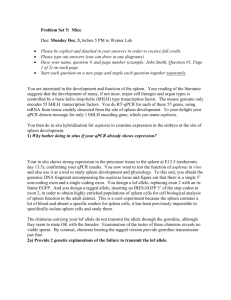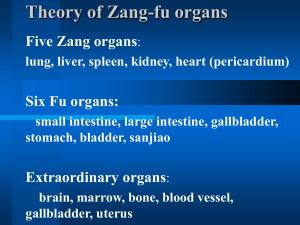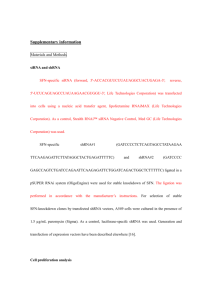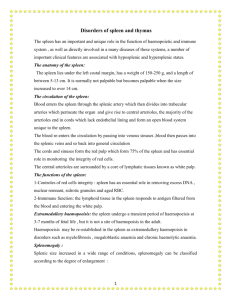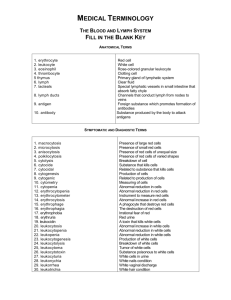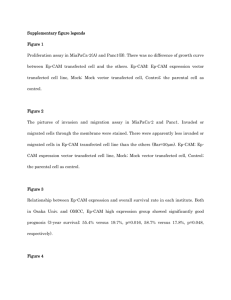Supplementary Information (docx 102K)
advertisement
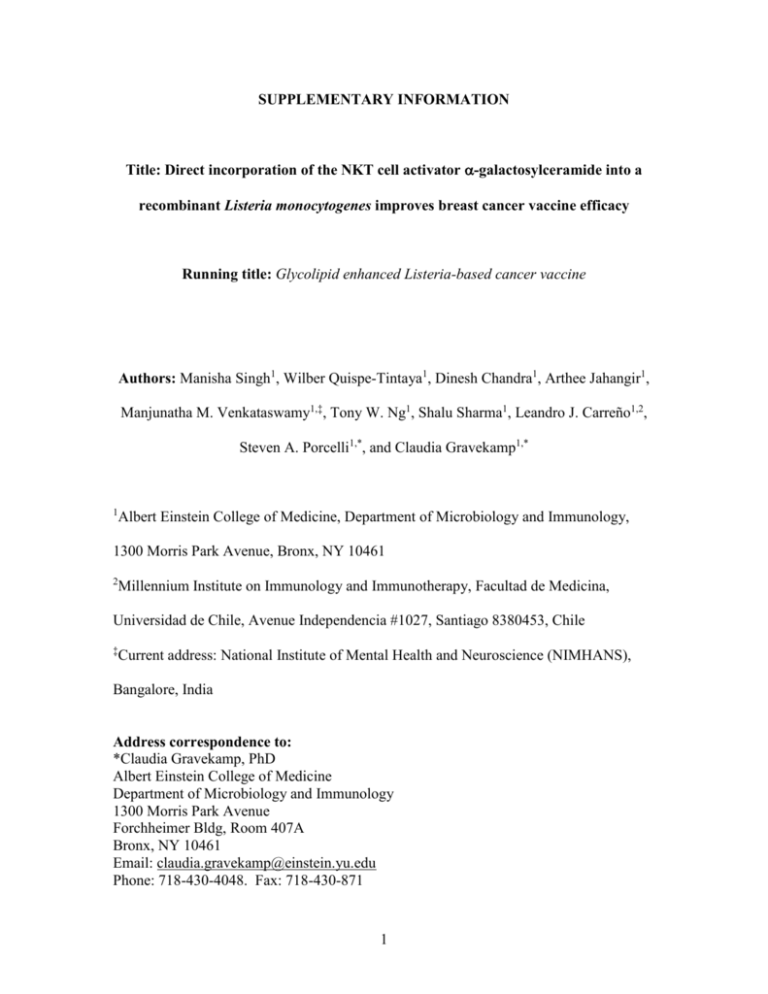
SUPPLEMENTARY INFORMATION Title: Direct incorporation of the NKT cell activator -galactosylceramide into a recombinant Listeria monocytogenes improves breast cancer vaccine efficacy Running title: Glycolipid enhanced Listeria-based cancer vaccine Authors: Manisha Singh1, Wilber Quispe-Tintaya1, Dinesh Chandra1, Arthee Jahangir1, Manjunatha M. Venkataswamy1,‡, Tony W. Ng1, Shalu Sharma1, Leandro J. Carreño1,2, Steven A. Porcelli1,*, and Claudia Gravekamp1,* 1 Albert Einstein College of Medicine, Department of Microbiology and Immunology, 1300 Morris Park Avenue, Bronx, NY 10461 2 Millennium Institute on Immunology and Immunotherapy, Facultad de Medicina, Universidad de Chile, Avenue Independencia #1027, Santiago 8380453, Chile ‡ Current address: National Institute of Mental Health and Neuroscience (NIMHANS), Bangalore, India Address correspondence to: *Claudia Gravekamp, PhD Albert Einstein College of Medicine Department of Microbiology and Immunology 1300 Morris Park Avenue Forchheimer Bldg, Room 407A Bronx, NY 10461 Email: claudia.gravekamp@einstein.yu.edu Phone: 718-430-4048. Fax: 718-430-871 1 *Steven A. Porcelli, MD Albert Einstein College of Medicine Department of Microbiology and Immunology 1300 Morris Park Avenue Forchheimer Bldg, Room 416 Bronx, NY 10461 Email: steven.porcelli@einstein.yu.edu Phone: 718-430-3228. Fax: 718-430-8711 2 FIGURE LEGENDS Figure S1: Bone marrow dendritic cells (BMDCs) infected with I-αGC-LM induced efficient iNKT cell activation in vitro. BMDCs were isolated from naïve BALB/c mice, cultured for 9 days, and then infected with different MOIs (0.1, 0.5 and 1) of LM or IGC-LM during 3 hours at 37°C, treated with gentamicin (100 g/ml) for 1 hour to remove extracellular bacteria and cultured overnight. Then, BMDCs were co-cultured with DN3A4-1.2 a mouse iNKT cell hybridoma cell line (5 x 104 BMDCs and 5 x 104 iNKTs/well in 96 well plates). BMDCs treated with 100 ng/ml of GC were included as positive control. After 24 hours of co-culture, IL-2 secretion in the supernatants was determined by capture ELISA as described previously (Yu et al., 2005). The error bars represent the standard error of the mean (SEM). Figure S2: Detection of Mage-b expression in spleen cells by RT-PCR and Southern blotting. Spleen cells were transfected with pcDNA3.1-Mage-b as described previously (Kim et al., 2008). Briefly, spleen cells of tumor-bearing mice were transfected with pcDNA3.1-Mage-b (1 μg plasmid per 5x106 spleen cells) using Lipofectamine 2000. On the next day, RNA was isolated using Trizol according to the manufacturer’s instructions (Life Technologies, Carlsbad, CA). Conversion of 1 µg of mRNA (treated with DNAse I) into cDNA was performed with Superscript Pre-amplification system (Life Technologies). Subsequently, 10 µl of the cDNA was amplified by hot start PCR (Platinum PCR SuperMix, Life Technologies) (40 cycles at 94°C for 30 sec., 58°C for 30 sec., 72°C for 2 min.) in a thermocycler from Perkin-Elmer (Norwalk, CT) described 3 previously (Sypniewska et al., 2002). The forward and reverse primers were chosen in exons 1 and 2, respectively, to exclude genomic DNA contamination (F67: 5’ GAG CTT GATCCA CGA GTT C and R708: 5’AGG AGA CCTGTC CTA GGC)(Sypniewska et al., 2002). RT-PCR products were separated in an ethidium bromide-stained agarose gel, and transferred to an Immobilon-N+ membrane (Millipore Co., Bedford, MA). Hybridizations were performed using a Mage-b DNA probe labeled for chemiluminescence (enhanced chemiluminescence; Amersham) according to the manufacturer’s instructions. The Mage-b probe (GenBank accession number AY196960) was a cloned cDNA spanning the complete coding sequence which was verified by DNA sequencing. Expression of Mage-b was observed in the spleen cells transfected with Mage-b but not in spleen cells transfected with pcDNA3.1 or in non-transfected spleen cells. pcDNA3.1-Mage-b plasmid was used as a positive control. Lane 1: Spleen cells transfected with pcDNA3.1/RT-: Lane 2 Spleen cells non-transfected/RT-; Lane 3: Spleen cells transfected with pcDNA3.1-Mage-b/RT-; Lane 4: Plasmid pcDNA3.1-Mageb DNA control; Lane 5: Spleen cells transfected with pcDNA3.1/RT+; Lane 6: Spleen cells non-transfected/RT+; Lane 7: Spleen cells transfected with pcDNA3.1-Mageb/RT+. Figure S3: Confirmation of antigen specificity of restimulation assay in ELISPOT. To detect Mage-b-specific immune responses, 4 x 105 spleen cells of vaccinated or control mice were co-transfected with plasmids pcDNA3.1-Mage-b and pCMV-GM-CSF using Lipofectamine 2000 (1 μg of each plasmid per 5x106 spleen cells), as described previously (Kim et al., 2008). As negative control, co-transfection of pcDNA3.1-LacZ 4 and pCMV-GM-CSF was used. After 72 hrs, the frequency of IFN-producing cells was determined by ELISPOT according to standard protocols (BD Biosciences), using an ELISPOT reader (CTL Immunospot S4 analyzer, Cellular Technology Ltd, Cleveland, OH). To determine the CD8+ T cell component of the responses, spleen cells were depleted of CD8 T cells using anti-CD8 (Clone 53-6.7)-conjugated magnetic beads, according to the manufacturer’s instructions (Miltenyi, Auburn, CA). Here, we demonstrate that restimulation with Mage-b induced a significantly higher number of CD8 T cells producing IFNγ in spleens of mice that received Listeria-Mage-b compared to the control groups (Saline or LM)(A). In contrast, cells producing IFNγ were nearly absent after restimulation with LacZ (B), which demonstrates the antigen specificity of the restimulation assay. The results shown are representative of two experiments with N = 5 mice per group. Means and standard errors are shown. ***P < 0.001, ***P < 0.0001 (Mann-Whitney test). Figure S4: Improved CD8 T cell responses in the primary tumor following therapeutic immunization with I-GC-LM-Mb. BALB/c mice were injected with 104 4T1 tumor cells in the mammary fat pad and subsequently treated with various single agents or combination regimens. Single agents were given therapeutically as i.p. injections on days 3, 6 and 9, and consisted of saline (sham treatment), attenuated Listeria monocytogenes (LM), LM expressing Mage-b (LM-Mb) or α-galactosylceramide (αGC). Combination regimens consisted of five therapeutic injections of LM-Mb modified by direct incorporation of αGC (I-αGC-LM-Mb) (see Materials and Methods of the manuscript for details). Mice were euthanized on day 18 and tumor cell suspensions 5 were subjected to direct ex vivo analysis by flow cytometry of intracellular IFNγ+ cells, gating on CD8α+ lymphocytes. This experiment was performed once with N = 3-5 mice per group, and the results shown represent average values for means and standard errors of data from individual mice. Only the I-αGC-LM-Mb-treated group was significantly different from the saline treated control group. *P < 0.05 (Mann-Whitney test). REFERENCES Kim SH, Castro F, Gonzalez D, Maciag PC, Paterson Y, Gravekamp C (2008). Mage-b vaccine delivered by recombinant Listeria monocytogenes is highly effective against breast cancer metastases. Br J Cancer 99: 741-749. Sypniewska RK, Hoflack L, Bearss DJ, Gravekamp C (2002). Potential mouse tumor model for pre-clinical testing of mage-specific breast cancer vaccines. Breast Cancer Res Treat 74: 221-233. Yu KO, Im JS, Molano A, Dutronc Y, Illarionov PA, Forestier C, et al. (2005). Modulation of CD1d-restricted NKT cell responses by using N-acyl variants of alphagalactosylceramides. Proc Natl Acad Sci U S A 102: 3383-3388. 6

